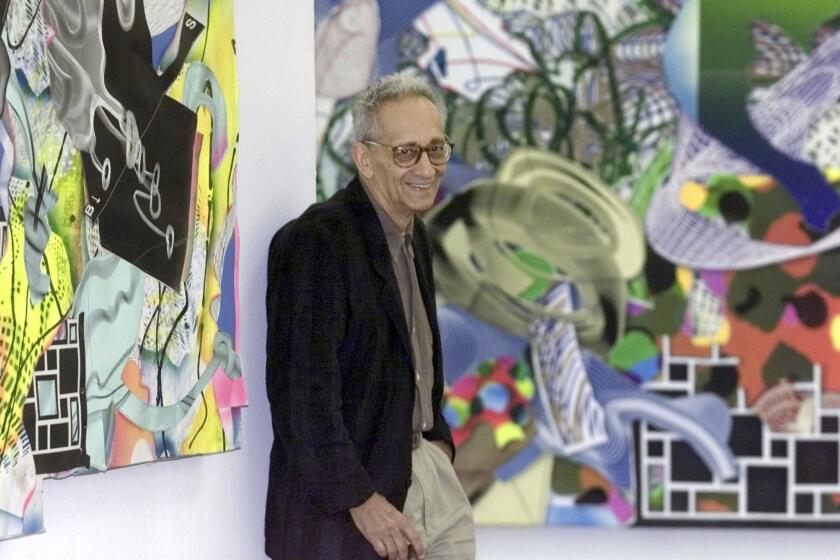Micro art’s big impact on digital
Four new exhibitions at the Museum of Jurassic Technology trace the roots of digital technology back to the 19th century. They pull the rug out from under the feet of visitors who think that the offbeat institution is a throwback, and they demonstrate that the idiosyncratic venue is ahead of its time -- and worlds apart from the bigger-is-better ethos of high-profile museums.
Compressing information like the most advanced gadgets, none of the four little shows takes up much floor space. The two largest occupy darkened galleries no bigger than many Beverly Hills closets. Installed in hallways, the smaller two feel less like featured presentations than playful invitations to pause on your way from one room to the next.
The first one you come across is “The Micromosaics of Harold Dalton (1829-1912).” It’s installed in a slender vitrine in the middle of a hall already jam-packed with works on paper and light-and-sound tableaux.
Protruding from the display case’s glass cover are the eyepieces of eight ordinary microscopes. Each allows you to see one of Dalton’s tiny still lifes. About the size of a child’s thumbnail, the exquisitely rendered images depict a variety of flowers and ferns tastefully arranged in vases and urns or as bouquets. Lizards, chickens, birds and butterflies adorn every scene, giving the little-known artist ample opportunity to indulge his love of saturated color. Each image resembles a stained-glass window whose iridescent palette covers the spectrum and includes such metallic tints as copper, silver and gold.
A wall label explains that every dot of color in Dalton’s works is a single section of a butterfly wing. In 1863, after contracting tuberculosis, the English scientist moved to France, where he spent his days capturing various species of butterflies. At night, he dissected their wings and sorted the cellular sections by shape and color. At the same time that the Impressionists were making paintings by placing solitary dabs of paint side-by-side, Dalton was making microscopic collages by arranging nature’s most stunning colors in harmonious compositions. Working with needles and single boar bristles, he had to breathe through a glass tube to keep from blowing the wing fragments away. When he completed a mosaic, he sandwiched it between two sheets of glass.
Dalton’s art is a testament to the virtues of human patience; the other hallway exhibition gives physical form to the volatile relationship between culture and nature. “Rotten Luck: An Exhibit of Failing Dice From the Collections of Ricky Jay” presents 30 antique dice that are decaying so rapidly they seem to be crumbling before your eyes.
Mounted in seven glass boxes that recall the window displays of fine jewelers, some look like sugar cubes dissolving in teacups. Others appear to be rusting, suffering the effects of extreme heat or prolonged exposure to subzero temperatures. Several ivory dice are turning green, like moldy food, and a group of nine looks as if it exploded.
The magic of Jay’s dice resides in the fact that nothing was done to them to produce these extreme effects. After decades of unchanging durability, they suddenly began to disintegrate. That’s because they were made of the first commercially viable form of plastic, an unstable nitrate-based celluloid invented by John Wesley Hyatt in 1868. Jay’s disfigured dice are modern memento mori, silent reminders of life’s unpredictability and the suddenness with which everything can fall apart.
The two largest exhibitions also feature the fusion of art, science and entertainment. The first consists of nine vectographs, 3-D photographs from the collection of Susan Pinsky and David Starkman. Mounted behind special goggles that sharpen the images, the vectographs are crisp black-and-white images whose depth of field mirrors that of the real world. What they depict (a film crew, a Navajo weaver and a scientific diagram, among other scenes) is far less interesting than how they do so -- with the vividness of the real thing.
A wall label explains that in 1939 Edwin H. Land unveiled the vectographic process, in which two sheets of polarized film are fused into one double-sided sheet. Unlike conventional 3-D images, which require side-by-side images, vectographs effectively put two pictures in one plane. This creates the impression, in the brain, that the eyes are seeing volumetric objects. Unfortunately, high production costs (and chemical instability) prevented vectographs from attaining the popularity of ordinary photographs.
The fourth exhibition features a new version of the vectographic process. Developed by Julius J. Scarpetti and Vivian K. Walworth, this process combines inkjet technology and a unique polarized substrate to create hauntingly beautiful 3-D images.
The 15 that make up “The Floral Radiographs of Albert Richards” pay homage to the chemical engineer and physicist who patented X-ray machines used in dental offices all over the world. Seen through hand-held glasses, each backlighted image presents a larger-than-life-size X-ray view of a fully blossomed flower. At once ghostly and futuristic, the various roses, lady slippers, calla lilies, jack-in-a-pulpits and star magnolias look like the genetically engineered offspring of jellyfish and stealth bombers.
As a group, the four exhibitions do for museums what the iPod does for CDs: compress vast amounts of artistry into unbelievably small spaces.
But unlike music played over headphones, the works in these shows do not promote social isolation. Rather than letting individuals get lost in their own heads, they draw on odd passions and eccentric expertise to inspire viewers to think freely and loosely -- to link far-flung ideas and idiosyncratic experiences in ways that engage the world’s weird beauty.
*
Museum of Jurassic Technology
Where: 9341 Venice Blvd., Culver City
When: Thursdays, 2-8 p.m.; Fridays-Sundays, noon-6 p.m.
Price: Free, donation suggested.
Contact: (310) 836-6131
More to Read
The biggest entertainment stories
Get our big stories about Hollywood, film, television, music, arts, culture and more right in your inbox as soon as they publish.
You may occasionally receive promotional content from the Los Angeles Times.






